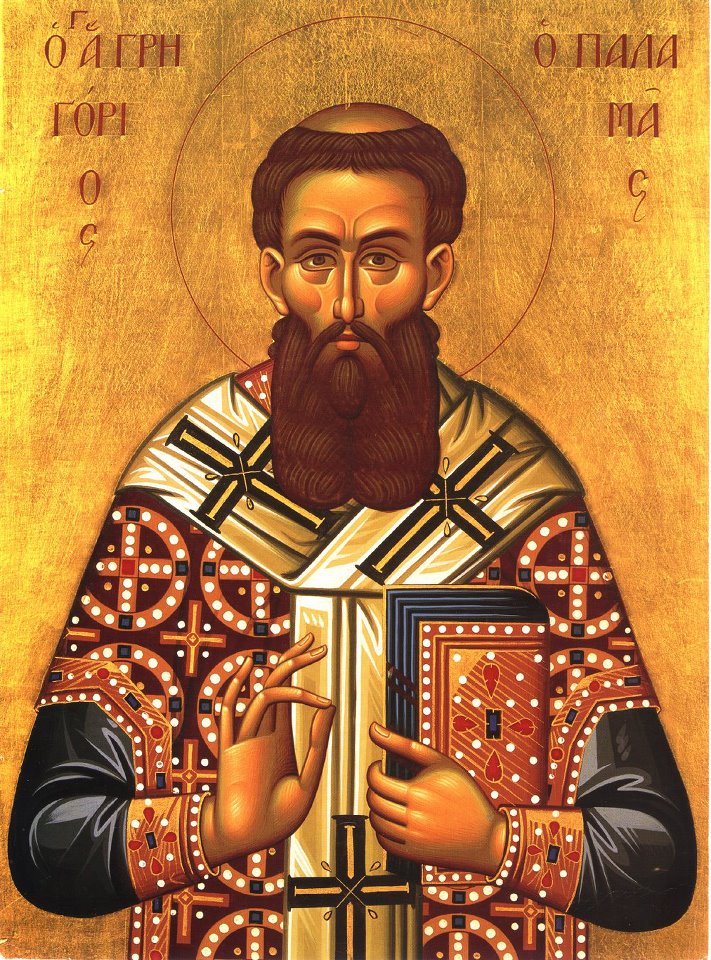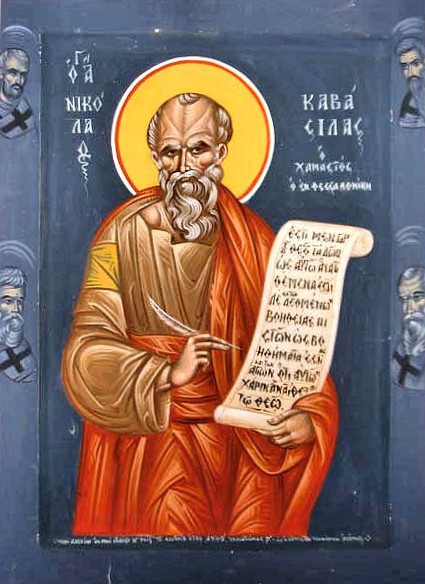Saint Gregory Palamas

The 14th century was the time of the Palamite controversy in the Eastern Church. St Gregory Palamas (1296–1359), a monk of Mount Athos, was a practitioner of the method of prayer called hesychasm (hesychia means ‘silence’). This method of prayer is centered in the continuous repetition of the name of Jesus, usually in the form of the Jesus Prayer: “Lord Jesus Christ, Son of God, have mercy on me, a sinner.” And a rigorous bodily discipline—emphasizing certain sitting postures and breathing techniques—is employed in order to help unite the mind and heart in God. Through the use of this method of prayer, the hesychast monks claimed to experience genuine communion with God, including sometimes a vision of the Uncreated Light of Divinity such as that seen by Moses on Mount Sinai, and by the Apostles Peter, James, and John at the Transfiguration of Christ on Mount Tabor.
In 1330 Barlaam the Calabrian, an Italo-Greek monk raised in an Orthodox family in southern Italy but educated in the Scholastic spirit prevailing in Western Europe at that time, came to Constantinople and accepted a chair in philosophy at the University of Constantinople. Barlaam, along with a number of other Byzantine humanists who were highly influenced by Western philosophical and theological ideas, ridiculed the practice of hesychastic prayer. They denied the possibility for human beings to be in direct, genuine communion with God.
Essence and Energies
In 1337 Gregory Palamas confronted Barlaam’s position and began his defense of hesychasm and the various contemplative practices of the Athonite monks. He confirmed the Orthodox doctrine that man can truly know God and can enter into living communion and relationship with Him through Christ and the Holy Spirit in the Church. He explained that the Essence (or Super-Essence) of God is utterly unknowable and incomprehensible, while at the same time, the actions, operations, or Energies of God, which are also uncreated and fully divine (such as the Divine Light), are communicated to people by divine grace and are open to human knowledge and experience. This is what is meant when Christians are said to become “partakers of the divine nature” (2 Pet 1.4).
A local council held in 1341 in Constantinople upheld Gregory’s teaching. Amid ten more years of political turmoil and theological controversy, local councils held in 1347 and in 1351 reaffirmed Gregory’s position as that of the Bible and the whole Tradition of the Orthodox Church. From that time this crucial theological distinction between the divine Super-Essence and the divine Energies became an official part of the doctrine of the Orthodox Church.
Saint Nicholas Cabasilas Writing on the Eucharist
Yet I have not mentioned the greatest thing of all. The Master is present with His servants not only to that extent, but He imparts of His own. He not only gives them a hand, but He has given us His whole Self. Wherefore we are the temple of the living God; our members are Christ’s members, whose Head the Cherubim adore. These very feet, these hands, depend on His Heart.
What then can you meditate upon with greater profit and pleasure than these things? For when we examine them, and these thoughts prevail in the soul, no evil thoughts will gain entry into us. Then it will come about that, as we learn of His benefits, we will increase in longing for our Benefactor. When we thus greatly love Him we become keepers of His commandments and participants in His purpose, for as He says, ‘he who loves Me will keep My commandments’ (Jn 14.15, 21).
Besides, when we recognize how great is our worth, we shall not readily betray it. We will not endure being slaves to a runaway slave when we have found out that a kingdom is ours. We shall not open our mouth in evil speech when we recollect the sacred banquet and that Blood which has reddened our tongue. How can we use our eyes to look on that which is not seemly when we have enjoyed such awesome Mysteries? We shall not move our feet nor stretch forth our hands to any wicked thing if the recollection of these things is active in our souls. Since they our members of Christ, they are sacred—as it were, a vial containing His Blood. Nay, rather, they are wholly clothed with the Savior Himself, not like a garment which we wear or the skin with which we are born, but much more, in that this clothing is far more closely united to those who wear it than their very bones.
(The Life in Christ, Sixth Book, parts 3 and 4)
Saint Gregory Palamas also served the Church as Archbishop of Thessalonica from 1350 until his death in 1359. Just nine years after his repose, he was glorified as a saint of the Church, with the second Sunday in Great Lent being dedicated to him in addition to November 14, the day of his death. This double annual commemoration underlines how important this great Church Father is in the mystical/theological tradition of the Orthodox Church.

Saint Nicholas Cabasilas (c. 1322–c. 1390), an important lay follower of Saint Gregory Palamas, wrote a very popular work called The Life in Christ which emphasizes the centrality of the Mysteries, or Sacraments, of the Church in the spiritual life of the people. For Saint Nicholas, partaking of the Holy Eucharist after proper preparation can be for any Christian—not only the monastics—the most profound moment of mystical communion with the Living Lord. Saint Nicholas also wrote a highly respected commentary on the Divine Liturgy.
